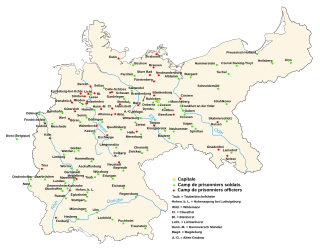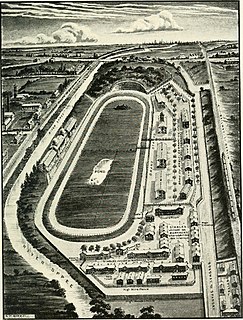
During World War I, German prisoner-of-war camps were run by the 25 Army Corps Districts into which Germany was divided. Around 2.4 million men were World War I prisoners of war in Germany.

Ruhleben internment camp was a civilian detention camp in Germany during World War I. It was located in Ruhleben, a former Vorwerk manor 10 km (6.2 mi) to the west of Berlin, now split between the districts of Spandau and Charlottenburg-Wilmersdorf. The camp was originally a harness racing track laid out north of the Berlin-Hamburg Railway line in 1908.
A civilian internee is a civilian detained by a party to a war for security reasons. Internees are usually forced to reside in internment camps. Historical examples include Japanese American internment and internment of German Americans in the United States during World War II. Japan interned 130,000 Dutch, British, and American civilians in Asia during World War II.
Ilag is an abbreviation of the German word Internierungslager. They were internment camps established by the German Army in World War II to hold Allied civilians, caught in areas that were occupied by the German Army. They included United States citizens caught in Europe by surprise when war was declared in December 1941 and citizens of the British Commonwealth caught in areas engulfed by the Blitzkrieg.

Numerous internment camps and concentration camps were located in France before, during and after World War II. Beside the camps created during World War I to intern German, Austrian and Ottoman civilian prisoners, the Third Republic (1871–1940) opened various internment camps for the Spanish refugees fleeing the Spanish Civil War (1936–1939). Following the prohibition of the French Communist Party (PCF) by the government of Édouard Daladier, they were used to detain communist political prisoners. The Third Republic also interned German anti-Nazis.

The situation of World War I prisoners of war in Germany is an aspect of the conflict little covered by historical research. However, the number of soldiers imprisoned reached a little over seven million for all the belligerents, of whom around 2,400,000 were held by Germany.

The Camp de Rivesaltes, also known as Camp Joffre, was an internment and transit camp in the commune of Rivesaltes in the department of Pyrénées-Orientales of the French Southern Zone during World War Two. Between August 11 and October 20, 1942, 2,313 foreign Jews, including 209 children were transferred from Rivesaltes via the Drancy internment camp to the Nazi extermination camp Auschwitz, where they were murdered. Serge Klarsfeld described the camp as the Drancy of the Southern Zone.

Holzminden prisoner-of-war camp was a World War I prisoner-of-war camp for British and British Empire officers located in Holzminden, Lower Saxony, Germany. It opened in September 1917, and closed with the final repatriation of prisoners in December 1918. It is remembered as the location of the largest PoW escape of the war, in July 1918: 29 officers escaped through a tunnel, of whom ten evaded subsequent recapture and managed to make their way back to Britain.

Beaune-la-Rolande internment camp was an internment and transit camp for foreign-born Jews, located in Beaune-la-Rolande in occupied France, it was operational between May 1941 and July 1943, during World War II.

During World War II, the French prisoners of war were primarily soldiers from France and its colonial empire captured by Nazi Germany. Although no precise estimates exist, the number of French soldiers captured during the Battle of France between May and June 1940 is generally recognised around 1.8 million, equivalent to around 10 percent of the total adult male population of France at the time. After a brief period of captivity in France, most of the prisoners were deported to Germany. In Germany, prisoners were incarcerated in Stalag or Oflag prison camps, according to rank, but the vast majority were soon transferred to work details (Kommandos) working in German agriculture or industry. Colonial prisoners, however, remained in camps in France with poor living conditions as a result of Nazi racial ideologies.

The Medal for civilian prisoners, deportees and hostages of the 1914-1918 Great War was a commemorative medal awarded to French civilians who were deported from the German occupied French territories and interned in camps during World War I. A law of 14 March 1936 announced the government's intention to officially recognize the sacrifices and patriotism of the French civilians that were forced from their homes and into prison camps to serve as hostages or to be detained with a new medal. The law of 25 August 1936 officially established the award.

During World War II, Belgian prisoners of war were principally Belgian soldiers captured by the Germans during and shortly after the Battle of Belgium in May 1940.

Georges Philibert Charles Maroniez was a French painter, specializing in landscapes with figures.

During the war of 1914-1918, the populations of the invaded and occupied regions of France were put under severe strain. Thus, at the end of hostilities, it seemed necessary to pay tribute to the courage of these people by rewarding them with several medals such as the Medal for victims of the invasion, the Medal of French Fidelity and the Medal for civilian prisoners, deportees and hostages of the 1914-1918 Great War. It was on the proposal of the Minister for the Liberated Regions that the Medal for victims of the invasion was created on 30 June 1921 in three classes.

The Political deportation and internment medal is a commemorative medal awarded by the Ministry for veterans and war victims of the French Republic to its citizens who were deported or interned by the German occupation forces during World War II.

Marguerite "Meggy"Frick-Cramer, born Renée-Marguerite Cramer, was a Swiss legal scholar, historian, and humanitarian activist. She was the first woman to sit on the governing body of an international organization, when she was made a member of the board of the International Committee of the Red Cross (ICRC) in 1918.

During World War I Switzerland accepted 68,000 British, French and German wounded prisoners of war (POW) for recovery in mountain resorts. To be transferred the wounded had to have a disability that would negate their further military service or interned over 18 months and deteriorating mental health. The wounded were transferred from prisoner of war camps unable to cope with the number of wounded and sat out the war in Switzerland. The transfer was agreed between the warring powers and organised by the Red Cross. The British entered into an agreement with Germany on May 2, 1916.

The green ticket roundup, also known as the green card roundup, took place on 14 May 1941 during the Nazi occupation of France. The mass arrest started a day after French Police delivered a green card to 6694 foreign Jews living in Paris, instructing them to report for a "status check".

The Mérignac internment camp, also known as the Beau-Désert internment camp, was a French internment and transit camp for Roma, Jews, French members of the Resistance, and political prisoners; it was located in the district of Beau-Désert in the commune of Mérignac, near Bordeaux, in German occupied France during World War II.

















